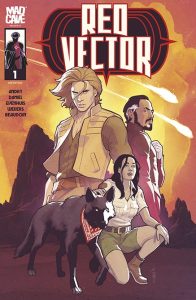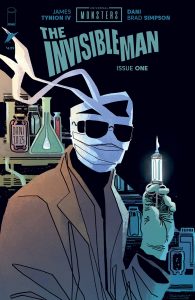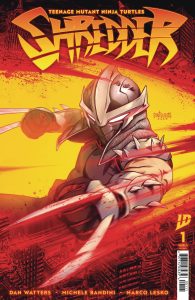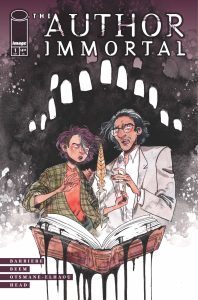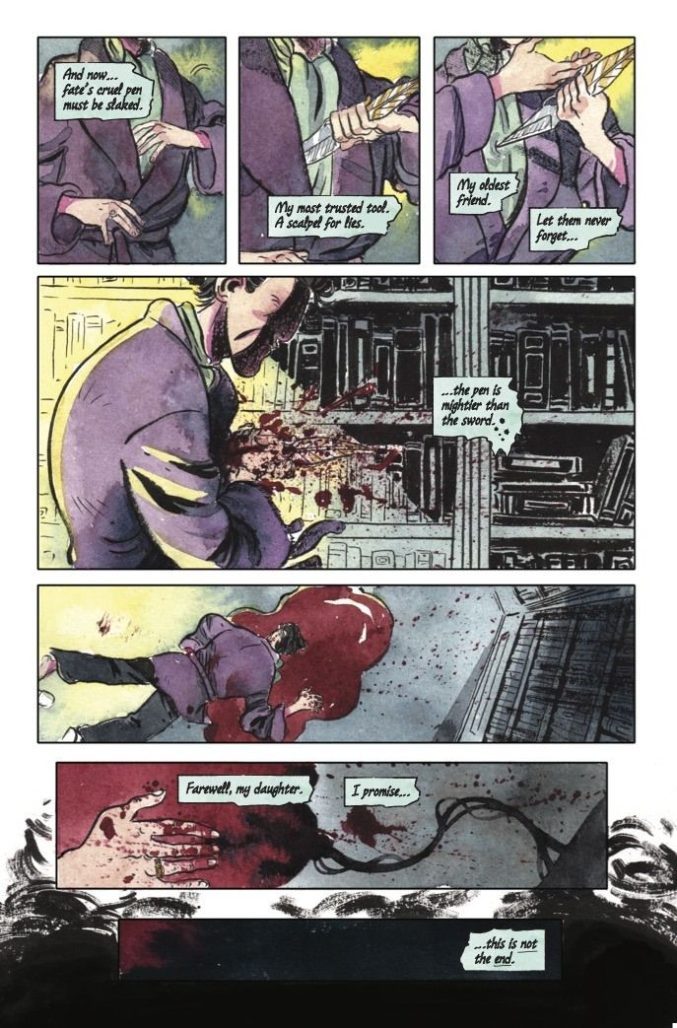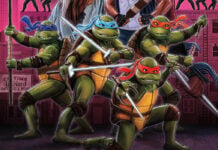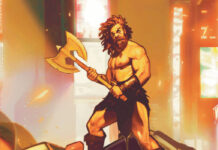In this week’s Wednesday Comics Reviews, the team reviews Mad Cave’s new sci-fi comic Red Vector, the latest classic monster revival with Universal Monsters: The Invisible Man, an instant-classic Hellboy one-shot, and more! Meanwhile, we look ahead with a review of new book The Author Immortal in our FOC Watch section, while Ensign’s Log returns with a review of the new Star Trek: Strange New Worlds comic. Plus, as always … The Prog Report!
 Red Vector #1
Red Vector #1
Writers: D.B. Andry and Tim Daniel
Artist: Chris Evenhuis
Colorist: Sjan Weijers
Letterer: Buddy Beaudoin
Publisher: Mad Cave Studios
Review by Khalid Johnson
I got near instant Star Wars vibes when opening up Red Vector #1. It’s sleek in presentation with a beautiful movie poster image to kick things off and vibrant colors throughout. Those colors by Sian Weijers pop right off of the page, complementing the art of Chris Evenhuis as letters by Buddy Beaudoin tie it all together nicely. We’re thrown right into a revolutionary conflict that feels like it’s at its climax, akin to Luke destroying the Death Star at the end of Episode IV. Those parallels and themes hold mirrors to real world events. Starships and imperial forces, an empire trafficking in dehumanization instantly classifying rebels as lesser; terrorists, a blanket term used by the state or empire to denote targets of violence.
The writing of David “DB” Andry & Tim Daniel is sharp and gets right to the central embodiment of the conflict through its dual and dueling protagonists, Dekk and Varsen. When presented with Varsen, the narrative quickly attempts to establish him as more empathetic than his brother, formerly exiled and returned with more righteous intentions, not wishing to escalate conflict. It is admittedly hard for me to parse that with the aforementioned current events, though the nuance of being born in an empire and having to unlearn it is not lost on me. Varsen is more level headed than Dekk, who has every reason to be hot headed if the enemy forces killed his family and loved ones. Then, enters Cora the woman and her dog Yuma, whose lives they crash land into.
From the onset of the story, the opening quotation is one of hope, “Can’t we just for once look up together and see… more.” and I want to cling desperately to hope, the hope of a shared humanity, but does an empire share that? When the mask of diplomacy falls, we see the violence, the willingness to escalate until there are no dissenters left and empire reveals the alienation from humanity, but then again, an empire isn’t a person.
I think what I’m left wondering at the end of dubious alliances and shared enemies, is how much unlearning is Varsen capable of when he has been in service to the very structure that killed everyone Dekk loved? Especially when Varsen’s response is that Dekk’s people were asking for too much? Peace is an empty platitude when lives are lost, peace atop a sea of corpses in service to maintaining oppressive structures is nothing. I question the utility and fragility of the ending alliance and think maybe it was too easily attained, but as the eyes of the empire fall on earth and bring the allegorical into reality, I wonder to what lengths the criticisms will go.
The hope for a common/shared humanity is something I resonate with deeply and as things fall into focus, I think Red Vector sets up some very interesting conflicts.
 Universal Monsters: The Invisible Man #1
Universal Monsters: The Invisible Man #1
Writer: James Tynion IV
Artist: DANI
Colorist: Brad Simpson
Letters: Becca Carey
Publisher: Image Comics / Skybound
Review by Clyde Hall
The Skybound/Image reexaminations of classic Universal Monsters have been horror comics more than deserving of consideration from fans of the genre. Each title has built solidly on the studio film foundations in clever, innovative ways. All this without altering the spirit or events of the movies themselves. Monsters like Dracula and Frankenstein (Baron and Creature) offer many options for added exposition and narrative POV. Others in the franchise, I imagine, present more of a challenge.
One of those being the Invisible Man. In a series of Halloween movie marathons at our local library, The Invisible Man and The Mummy are the only two classic Universal monster films that don’t get screenings. The reasons? Karloff in the mummy wrapping is too short a scene, and the rest of the film isn’t scary. And Jack Griffin as a scientist descending into madness after testing his invisibility formula upon himself is just too campy, under James Whale’s direction in The Invisible Man film.
The movie does have an askew sense of humor, but also a great deal of psychological horror that this new limited series, Universal Monsters: The Invisible Man, can tap into. And they’ve picked the perfect writer for that job in James Tynion IV. His reexamination of the central character, Dr. Jack Griffin, in the time leading up to his scientific breakthrough and its tragic outcome poses new possibilities and also speaks to similar maladies reflected in modern culture.
In the first issue, Tynion establishes the film characters of Griffin, his chemist employer Dr. Cranley, Cranley’s daughter Flora, and Griffin’s coworker Dr. Arthur Kemp. And whereas the 1933 film recounts offscreen the experimentations which led to Griffin’s quantum stealth breakthrough, here we meet a very visible and ambitious Dr. Griffin as he takes his first steps along the pathway to Things Man Was Not Meant to Know.
Under the benevolent employ of Dr. Cranley, young chemists Jack and Arthur are encouraged to work on their own areas of intellectual curiosity outside the everyday duties in his laboratory. When one of those lab exercises includes the rare substance monocaine, “a drug made from a flower grown in India…(that) draws color from everything it touches”, Griffin is fascinated and begins his own experimentations focusing on the substance. His test subject, a mouse, undergoes stages of transparency which become more absolute with every compound Griffin refines. With increasing doses, the mouse becomes truly invisible while at the same time growing more intelligent. By the end of the issue, Griffin cannot resist pushing headlong into new frontiers of questionable science, propelled by unlocking the secrets of monocaine, the results of his trial formulae on the test animal, and a building rivalry with his colleague, Arthur Kemp.
It’s in fleshing out the pre-monocaine affected Jack Griffin that Tynion expands on the initial film treatment of the H.G. Wells’ novel. It’s always been presented that a side effect of the monocaine experimentation was Griffin’s slow descent into megalomania and madness. In this narrative, we’re introduced to an increasingly sociopathic mindset in Griffin before one cc of monocaine ever hits his bloodstream. He shows an utter lack of regard for his kindly benefactor, Dr. Cranley. Currying Flora’s romantic interest becomes an exploitable venue for gaining more materials and latitude in Griffin’s side project. His veiled threats as Kemp tries bullying him in the lab and vying with him for Flora’s favor reveal Griffin as a scheming narcissist who already considers himself the smartest person in any room. With his monocaine formula, it’s clear he plans on increasing his intellect to become the smartest person in the world. In history. Then, he’ll never need bow to anyone else’s authority nor be plagued with matters of morality. He already sees himself beyond such things, and the power from his discovery will prove it.
It’s a frightening mindset, and one that mirrors a source of horror in current culture. From government leaders to social media trolls, pain is generated on many differing scales by the self-important who evade or block accountability. Almost anyone can say and express things from the relative safety of a keyboard and screen or a text via smartphone with little fear of consequences. Jack Griffin would approve.
In this iteration, he’s embracing the anonymity of invisibility as a concept, a way he can enact the dark thoughts he’s already harboring but managing, mostly, to suppress. He’s ready and willing for the opportunity of dodging any accountability for his actions. Tynion’s expression of this personality is chilling. Monocaine may drive Griffin over the edge, but he was already skating around the rim of the canyon. And Tynion even retains a certain morbid humor in Griffin’s musings, just one with all the camp flogged out.
It’s an approach echoed in the art of DANI. Even in scenes restaging a few instances from the Universal film, there’s no lingering sense of the comedic. Her styling fully embraces the tragedy and dread the script reveals brewing in the mind of Jack Griffin.
She displays him with profile edges already fading as he settles into an eddy bordering the society he disdains. She makes him smirk or grimace from the shadows as he plots how best to use those who can serve him, and how best to overcome any opposition. DANI further builds on Griffin’s unnatural perspective by rendering other characters as they are, contrasted by panels where Griffin’s view of them comes through, often accompanied by his inner thoughts. It’s an effective way expressing how even supportive, innocuous actions are perceived as threats by him.
Adding to the first issue’s overall appealing aesthetic of moody Victorian menace is DANI’s rendering of the film characters themselves. She distances the comic further from any connection to movie whimsy by giving Griffin only the most passing resemblance to Claude Rains. And while Kemp and Flora do resemble William Harrigan and Gloria Stewart respectively, the only remnants of Henry Travers as Dr. Cranley are eyebrows that might achieve lift in a stiff wind. It’s subtle deviation from going with screen-accurate representations, but a wise one. The opposite approach would likely distract and detract from the crafted, atmospheric tenor of trepidation the first issue builds.
The artwork also overcomes one of the more challenging aspects of adapting this Universal character to a graphic story form. While other monsters have the iconic Jack Pierce practical makeups or the Millicent Patrick gill-man designs as visual anchors, Griffin’s invisibility is a comics tale hindrance. What looks amazing on the silver screen thanks to painstaking mattes, composites, and practical special effects in the days before green screens and CGI doesn’t exactly translate into excitement on the printed page. But the glimpses we get of the DANI method for translucence and eventual invisibility works exceptionally well here, owing also to Brad Simpson on colors.
The first issue of Universal Monsters: The Invisible Man delves into the brilliant scientist behind the tragic tale while simultaneously casting deep shadows over how closely Dr. Jack Griffin navigates the line between genius and insanity. Depending on how this iteration continues over the next three issues, the underlying tone of the story itself may shift. For the characters around Griffin, a tragedy, for the reader, more deserving comeuppance. The pace set for this limited series leaves plenty of time for exploring the inner workings of either an invisible man going insane thanks to side effects from an untested chemical, or a madman made worse when intoxicated with the power of unaccountability. Maybe both.
 Hellboy and the B.P.R.D.: Professor Harvey Is Gone #1
Hellboy and the B.P.R.D.: Professor Harvey Is Gone #1
Writer: Mike Mignola
Artist: Giuseppe Manunta
Letterer: Clem Robins
Publisher: Dark Horse Comics
Review by Jared Bird
England, 1987. When paranoid antiquities academic Professor Harvey goes missing under mysterious circumstances, Hellboy must set out to find him, but things get dangerous when the same entity after the Professor might be after Hellboy himself as well. Featuring a story by series creator and visionary Mike Mignola, and art by Italian illustrator Giuseppe Manunta (Une Table Pour 3) this one-shot tells yet another adventure set during Hellboy’s time as an agent of the Bureau for Paranormal Research and Defence, removed from the franchise’s ‘core’ narrative.
Hellboy is called to the scene by Susan Smith, a former student and current assistant to Professor Harvey, after he disappears mysteriously shortly after being delivered a package. The package contains the ‘Nasser Madona’, a statue of a woman found in Egypt of undetermined origin. As Hellboy investigates, he has to face the demoness Ithia, who longs to be adored and loved. Whilst this issue is advertised as a one-shot, it doesn’t necessarily conclude its own story very well, with a bit of an open ending that seems to imply we will see more of these characters and concepts to come. Out of the new characters, Susan Smith is the highlight, having a fun and banter-fuelled dynamic with Hellboy that is a joy to read. Professor Harvey himself comes off as slightly pathetic, and not necessarily in a sympathetic way, while Ithia is left underutilised and subjected to a really tasteless and crass character design that seems somewhat uncharacteristic for the greater Hellboy universe. These characters are all fun and can be used more, because the main problem with the issue is simply how quickly it wraps everything up compared to the time it takes setting it up, which makes it feel anticlimactic. The central mystery of this issue ties into the ongoing Hyperborea storyline, which does make me believe that there’s a reason it cuts off so suddenly, but it does hinder the storytelling of the issue.
Mignola as always does a great job at the scripting and dialogue. He’s a legendary creator by now and for good reason, so you can expect a level of consistency to his work. This is a good example of that, a solid fun effort from him with some interesting characters and concepts, but limited by the lack of space to expand or explore further. Mignola as a writer almost always works better within the grand design, so it becomes difficult to fault one single issue story in a much larger puzzle, but it’s definitely not his best single issue story either. Manunta’s artwork is great throughout, gorgeous and lush and detailed with a distinct bande dessinée style to it that really works in the book’s favour, allowing it to look gorgeous. The sections set within ruins and ancient spaces are beautifully illustrated, stuffed to the brim with detail, and it’s a great showing from an art perspective.
Overall, Hellboy and the B.P.R.D: Professor Harvey is Gone #1 is a fun albeit flawed single-issue addition to the larger Hellboy franchise. Whilst it ties into ongoing narratives and story threads, it feels incomplete when looked at for its own merit, coming to an anticlimactic conclusion that just doesn’t hit the way it’s supposed to. Whilst it may work better in a larger context, and it features lush and staggering art from a talented illustrator, the issue itself is a solid if unremarkable one.
 Teenage Mutant Ninja Turtles: Shredder #1
Teenage Mutant Ninja Turtles: Shredder #1
Writer: Dan Watters
Artist: Michele Bandini
Colorist: Marco Lesko
Letterer & Designer: Darran Robinson
Publisher: IDW Publishing
Review by Jordan Jennings
Following recent events, Oroku Saki (aka the Shredder) has returned to New York City to reclaim his former hideout only for the former Foot Clan Master to discover someone has usurped his rule and laid claim to his old base. A solo-Shredder story isn’t unheard of in the world of TMNT comics. The character has enough depth to him that it warrants exploration. Writer Dan Watters is well suited for this kind of work. Watters’ characterization of Shredder is on the surface no different than most media portrayals—a ruthless, criminal warlord. Yet, something about this Shredder is off. Watters has this gift for finding the simple hook in a story that everyone can relate with.
For all of its ninja fights and criminal procedural elements, Shredder #1 is a story of a broken man trying to reclaim what is his. This speaks to everyone in some capacity. Sure, Shredder may be doing this by going Kill Bill on a bunch of ninja priests, but we all have been at our lowest trying to find dignity.
Now, I will be the first to admit I haven’t kept up with the TMNT line in several years, through no fault of the stories. It’s been something I have been wanting to read from start to finish and just haven’t had the time. I was pleasantly surprised by how new-reader friendly this issue was. I came into this story not knowing too much about Shredder’s current status quo, but it doesn’t matter. Watters crafts the story in a way that it doesn’t affect the readers’ enjoyment of the issue if they know the current story or not. Instead the issue sets out a clear motivation and direction that resonates with readers.
The art by Michele Bandini is well executed. The story elements and action beats are clean and easy to follow. The fight in the Foot Clan hideout is well choreographed and makes for a great opening action set piece. It’s sets up Shredder as a threat but quickly shows the reader that Shred-head is ready to reclaim his throne and has a journey ahead him. The only quibble I have with the art is the figure work of the characters. There is a sense of rigidity to the characters that doesn’t feel like artist’s intent. There is a lot of promise to the story but I hope there will be more fluidity as Bandini gets into the flow of the series.
Teenage Mutant Ninja Turtles: Shredder #1 is an excellent jumping on point for new and lapsed readers of the TMNT alike. It’s full of well illustrated action and well written intrigue that will entertain everyone.
 Masterminds #1
Masterminds #1
Writer: Zack Kaplan
Artist: Stephen Thompson
Colorist: Thiago Rocha
Letterer: Hassan Otsmane-Elhaou
Publisher: Dark Horse Comics
Review by Tim Rooney
Ensign’s Log Stardate 8262025
As IDW’s Star Trek comics continue to expand, Ensign Avery Kaplan has enlisted here to keep a careful log!
 Star Trek: Strange New Worlds – The Seeds of Salvation #1
Star Trek: Strange New Worlds – The Seeds of Salvation #1
Writer: Robbie Thompson
Artist: Travis Mercer
Colorist: JP Jordan
Letterer: Jodie Troutman
The first issue of the next comic miniseries to be based on the ongoing Paramount+ series, Star Trek: Strange New Worlds: The Seeds of Salvation #1, is beaming into your local comic shop this week.
Written by Robbie Thompson with art by Travis Mercer, colors by JP Jordan, letters by Jodie Troutman and design/production by Neil Uyetake, this story follows the crew of the U.S.S. Enterprise under Captain Pike as they venture to an outpost on a planet that’s encased in ice. As mentioned in the press for the title, the story introduces a new character: a robot with some unique idiosyncrasies. This initial entry in the miniseries sets up the adventure, and teases the action that’s to come. I enjoyed the stylized artwork, which gives an interesting flair to the now-familiar crew.
I also thought a few of the pages had unusually engaging layouts. Setting the action on an ice planet with an ocean is a good use of the comics medium, since it’s unlikely some of these elements could be included on an episode of the live action series. While the issue does include a stardate, I’m still a little unclear on where exactly it fits in the show’s timeline. Nevertheless, this issue contains some promising elements that could be developed to great effect in subsequent issues. Jordan’s colors are well suited to the action, and Troutman’s lettering is always excellent.
For Trekkies who need more Strange New Worlds in their life, The Seeds of Salvation #1 should be added to your pull list.
FOC Watch
The following comic is available for pre-order now.
 The Author Immortal #1
The Author Immortal #1
Writer: Frank Barbiere
Artist: Morgan Beem
Letterer: Hassan Otsmane-Elhaou
Designer: Sasha Head
Publisher: Image Comics
Due Out: October 1, 2025
Review by Zack Quaintance
There’s something about turning creative aspirations into horror comics that just works (from the Vault Comics book a few years back, Fearscape, to the recently concluded You’ll Do Bad Things). I think it has to do with the idea that desire is the root of all suffering. How do you make something scary? Make your protagonist suffer, or, at least, threaten them with suffering at every turn. And who suffers more than an artist with unfulfilled aspirations? Not many. The fact that these characters are largely comfortable and suffering of their own accord (depending on perspective), makes for a great story, especially for avid comics readers, a group wherein a not insignificant number harbor their own creative dreams.
All this is to say that The Author Immortal #1 (which is available for pre-order now ahead of its Oct. 1 release date) is the latest comic to turn writerly aspirations into an immersive and engaging horror comic. The book is scripted by Frank Barbiere with art by Morgan Beem, letters by Hassan Otsmane-Elhaou, and design by Sasha Head. It features a plot that appears simple on its surface, but has a series of rich and complex layers taken right from the zeitgeist of our moment.
The book’s main character is a (mostly) failed writer, who after years of self-publishing has resigned himself to a more harrowing fate — teaching. Specifically, teaching college. And our authorly protagonist is not a great guy, not really. He’s engaged to a woman much younger than him, and he’s cheating on her with a student. She works as his assistant and clearly idolizes him — and when he travels away from her for a few days, we catch him browsing escort listings online (hey, there’s that desire is the root of all suffering again!).
The plot gets going for our hero when he is called to meet with a famous writer, who is a stand-in for J.K. Rowling–a very wealthy woman with views for which she has become a pariah, despite authoring a beloved YA book series years ago. Our hero is also father to a transgender son, and despite all of this, gets into business with the Rowling analog. These are all interesting surface elements, torn from matters of the day. But where the book really shines is with its teases of what feels like portal fantasy, mixed with deep, visually-engaging horror.
There’s a mysterious darkness that lurks at the edges of all the real-world plotting above, waiting to terrorize the characters on the page. It’s rendered perfectly by Beem’s linework and colors, which are perfect for making fluid work of this book’s reality. Berbiere’s scripting does a great job with pacing, as well as with deploying his horror touches at the exact right moments to enhance the more grounded drama without ever taking away from it. This script also does a great job incorporating multiple time periods in a way that coheres and enhances its themes. And, of course, there’s no better letterer for a genre-busting book than the always-excellent Otsmane-Elhaou.
Overall, I found The Author Immortal #1 to be an excellent first issue. It’s a dense read (complimentary) with richly-drawn characters whose problems feel drawn right from several discussions of the day. If you like horror comics, you’d do well to pick this one up, especially if (like me) you enjoy horror comics about writers.
The Prog Report
2000AD 2447 (Rebellion Publishing): This week’s Prog is a bumper issue, and as such, it intermingles easy jump on points with continuations of ongoing strips. And, I’m happy to say, the new stuff is all stellar, particularly the artwork. The lead story is a standalone Dredd outing called Judge Dredd: Free Cherese by writer Geoffrey D. Wessel, artist Nick Roche, colorist Jack Davies, and letterer Annie Parkhouse. Roche’s take on Dredd is really great stuff, with clean lines and hard-hitting panels when needed (I think one panel of Dredd kicking in a door actually shot some splinters out of my tablet). The story is good too, but the artwork in this one is just a pleasure. My other favorite this week was Herne & Shuck: Be Here Now by writer David Barnett, artist Lee Fillmore, colorist Gary Caldwell, and letterer Simon Bowland. It can be read as a standalone story, but it also puts some plot pieces into place that seem certain to be revisited at some point. Moreover, these characters are great, the writing of them is fun, and the story has a nice, tight structure. All in all, a solid bumper issue. This week’s cover (above) is by Cliff Robinson with colors by Dylan Teague. As always, you can pick up a digital copy of The Prog here. —Zack Quaintance
Column edited by The Beat’s reviews editor, Zack Quaintance.
Read past entries in the weekly Wednesday Comics reviews series or check-out our other reviews here!



